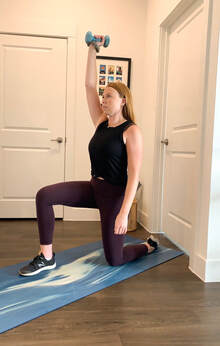|
By Dr. Katie Casto, PT, DPT  Injuries are common. Most of us have experienced an injury at some point in our lives and know how frustrating it can be to have to sit out of a sport, lose progress on our fitness journey, not be able to go to work, or not be able to participate in the activities that we want to do. Did you know that:
Surprising? Although injury rates differ across sports, activities, age groups, sex, etc. injuries are common across the board, and we can and should take steps to reduce our risk for injury. Why do injuries occur? Injuries can occur for many reasons, but certain factors are common culprits of injuries:
Can we prevent injuries? We have established that injuries are common and that certain factors may predispose someone to sustaining an injury. However, that doesn’t mean we can’t do anything about it. The good news is that there is a lot of solid evidence that injury prevention programs can and do work.
How can Physical Therapists help prevent injuries? As physical therapists, we have been extensively trained and have in-depth knowledge of the body and how it functions, as well as prescribing exercise, screening for poor movement patterns, identifying impairments and developing programs to address those specific impairments. We are movement specialists! We can work with you one on one to help identify risk factors that may predispose you to injury and address them to reduce the risk of an injury actually occurring. What if I’m already injured? Physical therapists can work with you to help reduce the risk of sustaining an injury by adequately preparing you for whatever activity you would like to participate in. However, this doesn’t mean we can prevent all injuries. Inevitability, injuries can still occur, and if and when that happens we are there to help with your recovery. We can address injuries early on which is crucial for improving outcomes and prognosis and preventing further downstream costs. There is substantial research evidence to support seeing a physical therapist early on after an injury to improve outcomes.
Research shows us that in MANY cases seeing a physical therapist sooner after an injury (rather than later) is a good idea. Don’t wait to come in! Don’t know where to start? Let us help guide you! We offer injury prevention movement screens- a simple full body screen done in just a few minutes- geared towards assessing your strength, range of motion, joint health, flexibility, movement patterns and susceptibility to injury. Then, we can bring awareness to areas of your body that may be beneficial to focus on or provide a few simple tips specific for YOUR body to help keep you healthy! References:
Arundale, Amelia J.H, Bizzini, Mario, Giordano, Airelle, Hewett, Timothy E, Logerstedt, David S, Mandelbaum, Bert, . . . Snyder-Mackler, Lynn. (2018). Exercise-Based Knee and Anterior Cruciate Ligament Injury Prevention. The Journal of Orthopaedic and Sports Physical Therapy, 48(9), A1-A42. Horn, M.E., Fritz, J.M. Timing of physical therapy consultation on 1-year healthcare utilization and costs in patients seeking care for neck pain: a retrospective cohort. BMC Health Serv Res 18, 887 (2018). https://doi.org/10.1186/s12913-018-3699-0 Kazis LE, Ameli O, Rothendler J, et al Observational retrospective study of the association of initial healthcare provider for new-onset low back pain with early and long-term opioid use BMJ Open 2019;9:e028633. doi: 10.1136/bmjopen-2018-028633) Messier, Stephen P, Martin, David F, Mihalko, Shannon L, Ip, Edward, DeVita, Paul, Cannon, D. Wayne, . . . Seay, Joseph F. (2018). A 2-Year Prospective Cohort Study of Overuse Running Injuries: The Runners and Injury Longitudinal Study (TRAILS). The American Journal of Sports Medicine, 46(9), 2211-2221. Lauersen, Jeppe Bo, Andersen, Thor Einar, & Andersen, Lars Bo. (2018). Strength training as superior, dose-dependent and safe prevention of acute and overuse sports injuries: A systematic review, qualitative analysis and meta-analysis. British Journal of Sports Medicine, 52(24), 1557-1563. Roos KG, Marshall SW, Kerr ZY, Golightly YM, Kucera KL, Myers JB, Rosamond WD, Comstock RD. Epidemiology of Overuse Injuries in Collegiate and High School Athletics in the United States. Am J Sports Med. 2015 Jul;43(7):1790-7. doi: 10.1177/0363546515580790. Epub 2015 Apr 30. PMID: 25930673. Wilber CA, Holland GJ, Madison RE, Loy SF. An epidemiological analysis of overuse injuries among recreational cyclists. Int J Sports Med. 1995 Apr;16(3):201-6. doi: 10.1055/s-2007-972992. PMID: 7649713. Mehrab, Mirwais, De Vos, Robert-Jan, Kraan, Gerald A, & Mathijssen, Nina M.C. (2017). Injury Incidence and Patterns Among Dutch CrossFit Athletes. Orthopaedic Journal of Sports Medicine, 5(12), 232596711774526-2325967117745263. Stevans, Joel M, Fitzgerald, G. Kelley, Piva, Sara R, & Schneider, Michael. (2017). Association of Early Outpatient Rehabilitation With Health Service Utilization in Managing Medicare Beneficiaries With Nontraumatic Knee Pain: Retrospective Cohort Study. Physical Therapy, 97(6), 615-624 Van Dyk, Nicol, Behan, Fearghal P, & Whiteley, Rod. (2019). Including the Nordic hamstring exercise in injury prevention programmes halves the rate of hamstring injuries: A systematic review and meta-analysis of 8459 athletes. British Journal of Sports Medicine, 53(21), 1362-1370. Comments are closed.
|
Meet Your TherapistJessica has been in Austin, TX for the past four years. She grew up in Idaho and attended PT school at Idaho State University. She completed an Orthopaedic Residency and became a Board Certified Orthopaedic Clinical Specialist in 2016. Archives
February 2022
Categories
All
|

 RSS Feed
RSS Feed